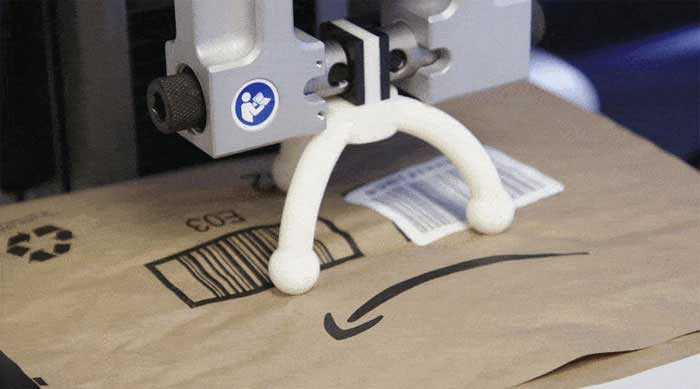Project Kuiper, a new initiative to launch a constellation of Low Earth Orbit satellites that will provide low-latency, high-speed broadband connectivity to unserved and underserved communities around the world. Amazon Kuiper's new state-of-the-art facility will consist of two buildings with a total of 219,000 square feet of space. It will include offices and design space, R&D labs, and prototype manufacturing facilities. Renovations on the facility are already underway, and the Kuiper team will move into the new site in 2020.
Amazon have been hard at work developing a new, fully-electric delivery system – Amazon Scout (in photo above) – designed to safely get packages to customers using autonomous delivery devices. These devices were created by Amazon, are the size of a small cooler, and roll along sidewalks at a walking pace. Customers can shop on the Amazon App or amazon.com and enjoy the same delivery options including fast, FREE Same-Day, One-Day and Two-Day shipping for Prime members. The devices will autonomously follow their delivery route but will initially be accompanied by an Amazon employee.
Amazon began using robotics in 2012 with its acquisition of Kiva systems; the Boston-based firm was later renamed Amazon Robotics. At the time, this marked Amazon's second-largest acquisition, signifying the investment the company was placing in innovations around artificial intelligence (AI) and automation. On the floors throughout Amazon's fulfillment centers, 2D barcodes are placed on the floor of robotics fields. Using these 2D barcodes, robots employ AI technologies to map out the most efficient route to bring associates the inventory pods needed. Once the route is mapped out, the robot will then take the correct pod of inventory to the associate for items to be either stowed or picked.
Amazon announces new automotive products and solutions at CES 2020. We've seen so many examples of how Alexa can make life easier and more convenient for customers.
Alexa is already available in dozens of vehicles from automakers like Audi, BMW, Ford, and Toyota. Automobili Lamborghini is bringing Alexa to its Huracan Evo range, and Rivian will integrate Alexa into its first two all-electric vehicles, the R1S and R1T, as well as its upcoming fleet of 100,000 all-electric Amazon delivery vans.
In addition to consumer products like Alexa and Fire TV, automotive companies are using Amazon Web Services (AWS) to fuel their digital transformation and accelerate new mobility solutions. This week at CES, we announced several new integrations powered by AWS: AWS is working with BlackBerry to develop a connected vehicle software platform for in-vehicle applications, combining the safety and security of BlackBerry's QNX real-time operating system with AWS's Internet of Things (IoT) Services in the cloud and in the car, and with Unity Technologies to showcase Unity Simulation, a cloud service to test, train, and validate an autonomous perception system. And AWS and Amazon Vehicles are partnering with Cadillac and ZeroLight to demonstrate a brand new, streamlined car-buying concept featuring the Cadillac XT6 at CES 2020. The showcase uses a range of engaging, personalized digital experiences to guide a customer through each stage of purchasing a vehicle.
Amazon's new recyclable mailer; the rigorous work of inventing Amazon's new recyclable paper padded mailer required the ingenuity of scientists, engineers, and technicians at Amazon's packaging and materials lab. These experts, who obsess over the tiniest of details, have been able to capitalize on a curious reaction that happens when you heat a form of glue, similar to what's used to make cardboard boxes. "It creates a puffy material that's lightweight,” said Justine Mahler, senior manager with Amazon's customer packaging experience team. Lightweight recyclable cushioning is a "packaging dream,” she said.
A machine testing the recyclable mailer in the Amazon packaging lab. The recyclable padded mailer is made by sandwiching this "dream" material between sheets of lightweight paper. The resulting mailer protects customer orders, without needing to rely on bulkier boxes which takes up space and causes Amazon airplanes, semi-trucks, and delivery vans to depart with fewer customer orders aboard. Packing more orders in each load means fewer trips, less fuel burned, and a smaller carbon footprint—all of which are key parts of achieving The Climate Pledge and reaching the Paris Agreement 10 years early.

